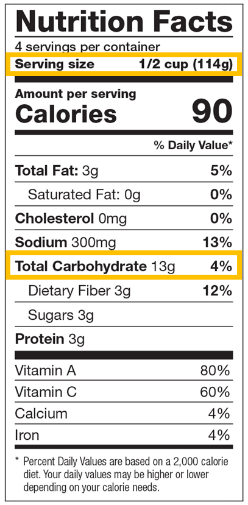Nutrition Facts labels for packaged foods are regulated by the Food and Drug Administration (FDA) to reflect new scientific information, including the link between diet and chronic diseases such as obesity and heart disease. Labels are designed to make it easy for consumers to make better informed food choices. They are the most reliable and easy-to-use resource for estimating the carbohydrate in foods.
For counting carbohydrates, the two most important and useful items on the label are:
- Serving Size
- Total Carbohydrate
“Total Carbohydrate” should be the main focus – NOT just the Sugars. Total Carbohydrate reflects all sugars, including sugar, starch, fiber, and sugar alcohol.
The “Sugar” listed under Total Carbohydrate is very misleading; all carbohydrate (sugar and starch) is included as part of “Total Carbohydrate.”
Be careful, it’s easy to confuse the weight in grams of the food item with grams of Total Carbohydrate.

A Word About “Net carbs,” “Impact Carbs” and “Active Carbs”
These terms are NOT regulated by the FDA. They have often been created by food manufacturers to appeal to the low-carb diet market. In these cases, manufacturers have subtracted all fiber and sugar alcohol from the Total Carbohydrate to make it more appealing to the consumer.
It is recommended to use “Total Carbohydrate” unless otherwise recommended by your healthcare provider.
Fiber - Includes all soluble and insoluble fiber. According to the Academy of Nutrition and Dietetics:
- If food (i.e. 1 cup of broccoli) has 5 or more grams of fiber per serving, subtract half of the grams of fiber from the Total Carbohydrate when you are calculating total carbohydrates for insulin dosing.
Sugar - Includes all naturally occurring and/or added sugars and is included in the Total Carbohydrate value
- Do not discount a food because it is high in sugar. Some healthy foods, such as fruit and milk, have naturally occurring sugars.
Sugar alcohol - Reduced calorie sweeteners such as mannitol, sorbitol, and xylitol. According to the American Diabetes Association (ADA):
- If a food has 5 or more grams of sugar alcohol per serving, subtract half of the amount of sugar alcohol from the Total Carbohydrate when you are calculating total carbohydrates for insulin dosing.
15-Gram Carbohydrate Choices
The 15-Gram Carbohydrate Reference Guide serves as an easy-to-remember resource, because each food item represents a 15-gram carbohydrate choice. 15 grams is not a suggested portion, but a resource for estimating carbohydrate using easy math.
Please refer to the “ADA Exchange list for Diabetes” for a complete list: https://www.uaex.edu/publications/pdf/FSHED-86.pdf
The t:slim X2 insulin Pump uses the settings in your active Personal Profile (your individualized settings for basal rate, correction factor, carbohydrate ratio, and target BG) to calculate the recommended delivery for food boluses and correction boluses based on your target BG. When a total carbohydrate is entered during bolus programming, your Tandem Pump will calculate a recommended bolus.
Carbohydrate counting and insulin pump therapy together match insulin more precisely with carbohydrate ingested than multiple daily injections. It allows more flexibility with food choices and meal timing.
If you don’t already have a Tandem pump, we have a free demo app that will let you try out our pump interface on your Apple or Android mobile device. You can experiment with pump settings, personal profiles, and some practice blousing. You can download the app from here.
Craving for more? Check out the complete Carbohydrate Counting series:
Carb Counting #1: Food & Blood Glucose
Carb Counting #2: Nutrition Labels
Carb Counting #3: Other Influences
Carb Counting #4: Alcohol
The material provided is for educational and training purposes only, is general in nature, and is not intended to replace the medical advice of your doctor or healthcare provider. You are encouraged to seek advice from a competent medical professional regarding the applicability of any recommendation with regard to your symptoms or condition. It is important that you do not reduce, change or discontinue any treatment without first consulting your healthcare provider.
From time to time, we may pass along: suggestions, tips, or information about other Tandem Insulin Pump user experiences or approaches to the management of diabetes. However, please note individual symptoms, situations, circumstances and results may vary. Please consult your physician or qualified health care provider regarding your condition and appropriate medical treatment. Please read the Important Safety Information linked below before using a Tandem Diabetes Care product.